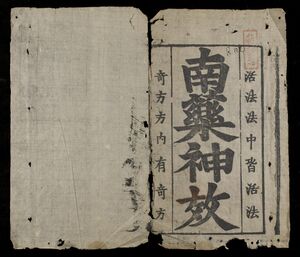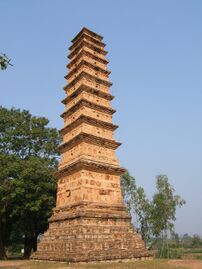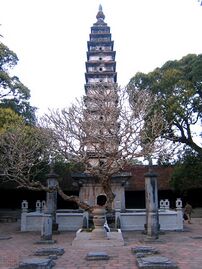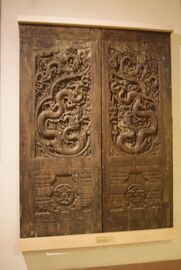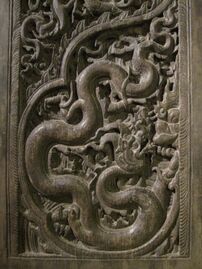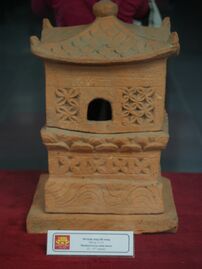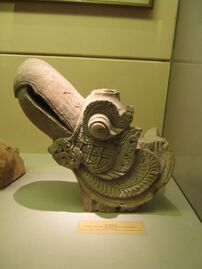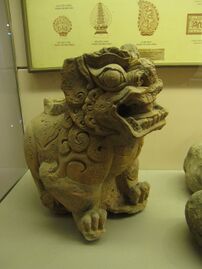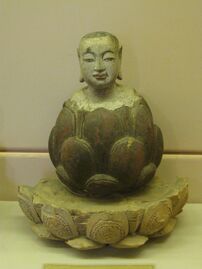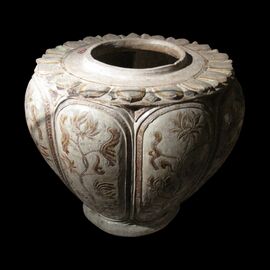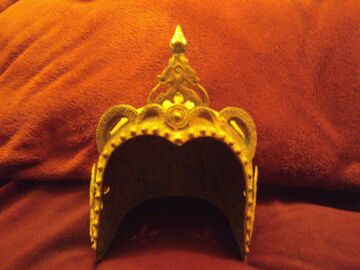أسرة تشان
21°02′15″N 105°50′19″E / 21.03750°N 105.83861°E
Đại Việt Đại Việt Quốc (大越國) | |||||||||
|---|---|---|---|---|---|---|---|---|---|
| 1225–1400 | |||||||||
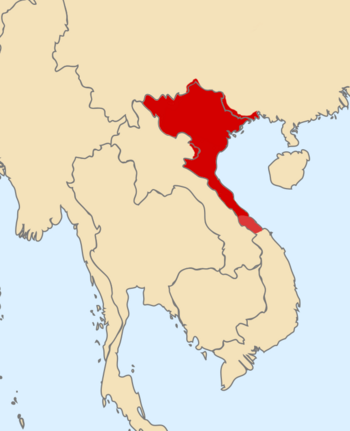 Map of the Trần dynasty | |||||||||
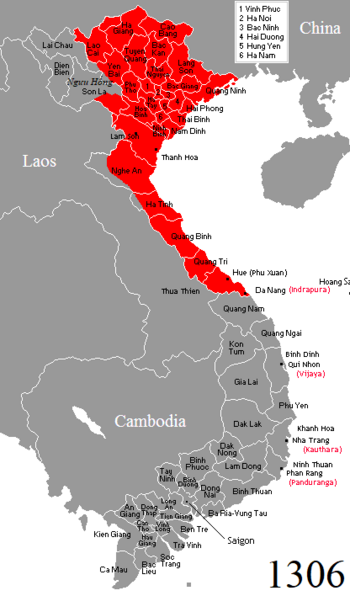 The territory of Đại Việt in 1306 after the marriage of Vietnamese princess Huyền Trân and Cham king Jaya Simhavarman III. The province of Chau O (Cham: Vuyar) and Chau Ly (Cham: Ulik) was ceded to Đại Việt as dowry. | |||||||||
| الوضع | Internal imperial system within Chinese tributary[1][2] (Song 1225–1258) (Yuan 1258–1368) (Ming 1368–1400) | ||||||||
| العاصمة | Thăng Long (1225–1397) Thanh Hóa (temp) (1397–1400) | ||||||||
| اللغات المشتركة | Literary Chinese[3] Vietnamese[3] | ||||||||
| الدين | Buddhism (official), Taoism, Confucianism | ||||||||
| الحكومة | Monarchy | ||||||||
| Emperor | |||||||||
• 1226–1258 | Trần Thái Tông (first) | ||||||||
• 1278–1293 | Trần Nhân Tông | ||||||||
• 1293–1314 | Trần Anh Tông | ||||||||
• 1398–1400 | Trần Thiếu Đế (last) | ||||||||
| Chancellor | |||||||||
• 1225 | Trần Thủ Độ (first) | ||||||||
• | Trần Quốc Toản | ||||||||
• | Trần Khánh Dư | ||||||||
• | Trần Quang Khải | ||||||||
• 1387 | Hồ Quý Ly (last) | ||||||||
| الحقبة التاريخية | Postclassical Era | ||||||||
• Coronation of Trần Cảnh | January 10 1225 | ||||||||
• Regent of Trần Thừa and Trần Thủ Độ | 1226 | ||||||||
| 1258, 1285 and 1287–88 | |||||||||
• Coup overthrown of Dương Nhật Lễ | 1370 | ||||||||
• Trần Thiếu Đế ceded the throne to Hồ Quý Ly | March 23 1400 | ||||||||
| العملة | Copper-alloy cash coins | ||||||||
| |||||||||
| اليوم جزء من | Vietnam China Laos | ||||||||
| Trần | |
|---|---|
| البلد | Empire of Đại Việt (Vietnam) |
| تأسست | 12th century |
| المؤسس | Trần Nhật Cảnh |
| آخر حاكم | Trần Quý Khoáng |
| الألقاب | |
| الأملاك | Thăng Long and Thiên Trường |
جزء من سلسلة عن |
|---|
| تاريخ ڤيتنام |
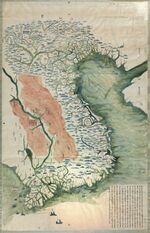 |
| خط زمني |
أسرة تشان أو تران [أ] (بالڤيتنامية: Nhà Trần, chữ Nôm: 茹陳)وتُعرف أيضاً بإسم بيت تشان House of Trần، كانت Vietnamese dynasty that ruled over Đại Việt from 1225 to 1400. The dynasty was founded when emperor Trần Thái Tông ascended to the throne after his uncle Trần Thủ Độ orchestrated the overthrow of the Lý dynasty. The Trần dynasty defeated two Mongol invasions, most notably during the decisive Battle of Bạch Đằng River in 1288.[6] The final emperor of the dynasty was Thiếu Đế, who was forced to abdicate the throne in 1400, at the age of five years old in favor of his maternal grandfather, Hồ Quý Ly.
The Tran improved Chinese gunpowder,[7] enabling them to expand southward to defeat and vassalize the Champa.[8] They also started using paper money for the first time in Vietnam.[9] The period was considered a golden age in Vietnamese language, arts, and culture.[10] The first pieces of Chữ Nôm literature were written during this period,[11] while the introduction of vernacular Vietnamese into the court was established, alongside Chinese.[12] This laid the foundation for the further development and solidifying of the Vietnamese language and identity.
تعيش في فيتنام من 1225 حتي 1400. وقد اطاح بها هو قوي لي المسئول في البلاط، بعد حكم دام مائة وخمسة سبعين عاماً.
التاريخ
الأصل والأساس
تشان المبكرة
غزوات المغول
السلام والتوسع جنوبا
الرفض
السقوط
الإقتصاد
الثقافة
الأدب
الفنون المسرحية
التعليم
| Year | Emperor | Ranked first | Note |
|---|---|---|---|
| 1232 | Trần Thái Tông | Trương Hanh Lưu Diễm |
[13] |
| 1234 | Trần Thái Tông | Nguyễn Quan Quang | [14] |
| 1239 | Trần Thái Tông | Lưu Miễn Vương Giát |
[15] |
| 1247 | Trần Thái Tông | Nguyễn Hiền | Trạng nguyên[16] |
| 1256 | Trần Thái Tông | Trần Quốc Lặc | Kinh trạng nguyên[17] |
| Trương Xán | Trại trạng nguyên[17] | ||
| 1266 | Trần Thánh Tông | Trần Cố | Kinh trạng nguyên[18] |
| Bạch Liêu | Trại trạng nguyên[18] | ||
| 1272 | Trần Thánh Tông | Lý Đạo Tái | Trạng nguyên[14] |
| 1275 | Trần Thánh Tông | Đào Tiêu | Trạng nguyên[19] |
| 1304 | Trần Anh Tông | Mạc Đĩnh Chi | Trạng nguyên[20] |
| 1347 | Trần Dụ Tông | Đào Sư Tích | Trạng nguyên[21] |
العلوم والتكنولوجيا
There is evidence for the use of feng shui by Trần dynasty officials, such as in 1248 when Trần Thủ Độ ordered several feng shui masters to block many spots over the country for the purpose of protecting the newly founded Trần dynasty from its opponents.[22] Achievements in science during the Trần dynasty were not detailed in historical accounts, though a notable scientist named Đặng Lộ was mentioned several times in Đại Việt sử kí toàn thư. It was said that Đặng Lộ was appointed by Retired Emperor Minh Tông to the position of national inspector (liêm phóng sứ)[23] but he was noted for his invention called lung linh nghi, which was a type of armillary sphere for astronomic measurement.[24] From the result in observation, Đặng Lộ successfully persuaded the emperor to modify the calendar in 1339 for a better fit with the agricultural seasons in Đại Việt.[25][26] Marquis Trần Nguyên Đán, a superior of Đặng Lộ in the imperial court, was also an expert in calendar calculation.[27]
Gunpowder
Near the end of the Trần dynasty the technology of gunpowder appeared in the historical records of Đại Việt. It was responsible for the death of the King of Champa, Chế Bồng Nga, after general Trần Khát Chân fired a cannon from his battleship in January 1390.[28] According to the NUS researcher Sun Laichen, the Trần dynasty acquired gunpowder technology from China and effectively used it to change the balance of power between Đại Việt and Champa in favour of Đại Việt.[8] As a result of this Sun reasoned that the need for copper for manufacturing firearms was probably another reason for the order of Hồ Quý Ly to change from copper coins to paper money in 1396.[29]
The people of the Trần dynasty and the later Hồ dynasty continued to improve their firearms using gunpowder. This resulted in weapons of superior quality to their Chinese counterparts. These were acquired by the Ming dynasty in their invasion of Đại Việt.[7]
Medicine
During the rule of the Trần dynasty, medicine had a better chance to develop because of a more significant role of Confucianism in society.[30][31] In 1261,[32] the emperor issued an order to establish the Institute of Imperial Physicians (Thái y viện) which managed medicine in Đại Việt, carrying out the examination for new physicians and treating people during disease epidemics.[30] In 1265 the institute distributed a pill named Hồng ngọc sương to the poor, which they considered able to cure many diseases.[33] Besides the traditional Northern herbs (thuốc Bắc), Trần physicians also began to cultivate and gather various regional medicinal herbs (thuốc Nam) for treating both civilians and soldiers. During the reign of Trần Minh Tông the head of the Institute of Imperial Physicians Phạm Công Bân was widely known for his medical ethics, treating patients regardless of their descent with his own medicine made from regional herbs;[30][34] it was said that Phạm Công Bân gathered his remedies in a medical book named Thái y dịch bệnh (Diseases by the Imperial Physician).[35]
The monk Phạm Công Bân, also known as Tuệ Tĩnh, who was a famous physician in Vietnamese history, was called the "Father of the Southern Medicine" for creating the basis of Vietnamese traditional medicine with his works Hồng nghĩa giác tư y thư and Nam dược thần hiệu.[36] Nam dược thần hiệu was a collection of 499 manuscripts about local herbs and ten branches of treatment with 3932 prescriptions to cure 184 type of diseases while Hồng nghĩa giác tư y thư provided people with many simple, easy-to-prepare medicines that produced effective results.[36][37]
معرض صور
Bình Sơn pagoda of Vĩnh Khánh Temple, Trần dynasty, Tam Sơn town, Lô river commune, Vĩnh Phúc province.
Pagoda of the Phổ Minh Temple
شجرة العائلة
 |
| Thái Tổ | |||||||||||||||||||||||||||||||||||||||||||||||||
| Thái Tông | |||||||||||||||||||||||||||||||||||||||||||||||||
| Thánh Tông | |||||||||||||||||||||||||||||||||||||||||||||||||
| Nhân Tông | |||||||||||||||||||||||||||||||||||||||||||||||||
| Anh Tông | |||||||||||||||||||||||||||||||||||||||||||||||||
| Minh Tông | |||||||||||||||||||||||||||||||||||||||||||||||||
| Nghệ Tông | Hiến Tông | Dụ Tông | Duệ Tông | Cung Túc | |||||||||||||||||||||||||||||||||||||||||||||
| Thuận Tông | Phế Đế | Nhật Lễ | |||||||||||||||||||||||||||||||||||||||||||||||
| Thiếu Đế | |||||||||||||||||||||||||||||||||||||||||||||||||
انظر أيضاً
ملاحظات
المراجع
- ^ خطأ استشهاد: وسم
<ref>غير صحيح؛ لا نص تم توفيره للمراجع المسماةbaldanza - ^ خطأ استشهاد: وسم
<ref>غير صحيح؛ لا نص تم توفيره للمراجع المسماةCengage - ^ أ ب Taylor 2013, pp. 108–121.
- ^ Hall 2008, p. 159.
- ^ Dutton, Werner & Whitmore 2012, p. 29–.
- ^ "Tran Dynasty". Britannica.com.
- ^ أ ب Tuyet Nhung Tran & Reid 2006, pp. 89–90.
- ^ أ ب Tuyet Nhung Tran & Reid 2006, pp. 75–77.
- ^ Chapuis 1995, p. 95.
- ^ Miller & Williams 2008, p. 249.
- ^ خطأ استشهاد: وسم
<ref>غير صحيح؛ لا نص تم توفيره للمراجع المسماة:0 - ^ خطأ استشهاد: وسم
<ref>غير صحيح؛ لا نص تم توفيره للمراجع المسماةlemanhthat - ^ خطأ استشهاد: وسم
<ref>غير صحيح؛ لا نص تم توفيره للمراجع المسماةNgo163 - ^ أ ب خطأ استشهاد: وسم
<ref>غير صحيح؛ لا نص تم توفيره للمراجع المسماةMai20 - ^ Ngô Sĩ Liên 1993, p. 166
- ^ خطأ استشهاد: وسم
<ref>غير صحيح؛ لا نص تم توفيره للمراجع المسماةNgo168 - ^ أ ب خطأ استشهاد: وسم
<ref>غير صحيح؛ لا نص تم توفيره للمراجع المسماةNgo172 - ^ أ ب Ngô Sĩ Liên 1993, p. 179
- ^ Ngô Sĩ Liên 1993, p. 182
- ^ خطأ استشهاد: وسم
<ref>غير صحيح؛ لا نص تم توفيره للمراجع المسماةNgo217 - ^ Ngô Sĩ Liên 1993, p. 267
- ^ Ngô Sĩ Liên 1993, p. 169.
- ^ Ngô Sĩ Liên 1993, p. 234.
- ^ "Đặng Lộ". Từ điển Bách khoa toàn thư Việt Nam (in الفيتنامية). Archived from the original on 2011-07-16. Retrieved 2009-12-08.
- ^ Ngô Sĩ Liên 1993, p. 246.
- ^ "Đặng Lộ: Nhà thiên văn học" (in الفيتنامية). Baobinhduong.org.vn. 2006-02-28. Retrieved 2009-12-08.[dead link]
- ^ "Trần". Từ điển Bách khoa toàn thư Việt Nam (in الفيتنامية). Archived from the original on 2011-07-16. Retrieved 2009-12-08.
- ^ Ngô Sĩ Liên 1993, pp. 282–283.
- ^ Tuyet Nhung Tran & Reid 2006, p. 77.
- ^ أ ب ت Alan Kam-leung Chan, Clancey & Hui-Chieh Loy 2001, p. 265.
- ^ Jan Van Alphen; Anthony Aris (1995). Oriental medicine: an illustrated guide to the Asian arts of healing. Serindia Publications, Inc. pp. 210–214. ISBN 0-906026-36-9.
- ^ Ngô Sĩ Liên 1993, p. 176.
- ^ Ngô Sĩ Liên 1993, p. 257.
- ^ Phạm Văn Sơn 1983, p. 215.
- ^ Nguyễn Xuân Việt (2008-12-26). "Y học cổ truyền của tỉnh Hải Dương trong hiện tại và tương lai" (in الفيتنامية). Haiduong Department of Science and Technology. Archived from the original on 2014-05-17. Retrieved 2009-12-09.
- ^ أ ب "Tuệ Tĩnh". Từ điển Bách khoa toàn thư Việt Nam (in الفيتنامية). Archived from the original on 2011-07-16. Retrieved 2009-12-09.
- ^ Alan Kam-leung Chan, Clancey & Hui-Chieh Loy 2001, pp. 265–266.
المصادر
- Alan Kam-leung Chan; Clancey, Gregory K.; Hui-Chieh Loy (2001), Historical perspectives on East Asian science, technology, and medicine, World Scientific, ISBN 9971-69-259-7
- Chapuis, Oscar (1995), A history of Vietnam: from Hong Bang to Tu Duc, Greenwood Publishing Group, ISBN 0-313-29622-7
- Dương Quảng Hàm (1968) (in vi), Việt-Nam văn-học, Trung-Tâm-Học-Liệu
- Dutton, George; Werner, Jayne; Whitmore, John K. (2012), Sources of Vietnamese Tradition, Columbia University Press, ISBN 978-0-231-51110-0, https://books.google.com/books?id=ZHD4Asj0FagC
- Hall, Kenneth R., ed. (2008), Secondary Cities and Urban Networking in the Indian Ocean Realm, C. 1400–1800, Comparative Urban Studies, 1, Lexington Books, ISBN 978-0-7391-2835-0, https://books.google.com/books?id=gyPjBevBHxcC, retrieved on 7 August 2013
- Mai Hồng (1989) (in vi), Các trạng nguyên nước ta, Hanoi: Education Publishing House
- Miller, Terry E.; Williams, Sean (2008), The Garland handbook of Southeast Asian music, Routledge, ISBN 978-0-415-96075-5
- National Bureau for Historical Record (1998) (in vi), Khâm định Việt sử Thông giám cương mục, Hanoi: Education Publishing House
- Ngô Sĩ Liên (1993) (in vi), Đại Việt sử ký toàn thư (Nội các quan bản ed.), Hanoi: Social Science Publishing House
- Phạm Văn Sơn (1983) (in vi), Việt sử toàn thư, Japan: Association of Vietnameses in Japan
- Taylor, K. W. (2013), A History of the Vietnamese, Cambridge University Press, ISBN 978-0-521-87586-8, https://books.google.com/books?id=6UHi9JXNokEC
- Tham Seong Chee (1981), Essays on Literature and Society in Southeast Asia: Political and Sociological Perspectives, Singapore: NUS Press, ISBN 9971-69-036-5
- Tuyet Nhung Tran; Reid, Anthony J. S. (2006), Việt Nam Borderless Histories, Madison, Wisconsin: University of Wisconsin Press, ISBN 978-0-299-21770-9
- Trần Trọng Kim (1971) (in vi), Việt Nam sử lược, Saigon: Center for School Materials
- Trương Hữu Quýnh; Đinh Xuân Lâm; Lê Mậu Hãn (2008) (in vi), Đại cương lịch sử Việt Nam, Hanoi: Education Publishing House
- Whitmore, John K. (2022). "The Sông Cái (Red River) Delta, the Chinese Diaspora, and the Trần/Chen Clan of Ðại Việt". Crossroads: An Interdisciplinary Journal of Asian Interactions. 19 (2): 210–232. doi:10.1163/26662523-12340011. S2CID 247914991.
Further reading
- Stuart-Fox, Martin (2003), China and Southeast Asia: Tribute, Trade and Influence, Allen & Unwin, ISBN 1-86448-954-5
- Lockard, Craig (2009), Southeast Asia in World History, Oxford University Press, ISBN 978-0-19-516075-8
- Tarling, Nicholas (1992), The Cambridge History of Southeast Asia, Volume one: From Early Times to C. 1800, Cambridge University Press, ISBN 0-521-35505-2
- Taylor, Keith Weller (1991), The Birth of Vietnam, University of California Press, ISBN 0-520-07417-3
- Thiện Đỗ (2003), Vietnamese supernaturalism: views from the southern region, Routledge, ISBN 0-415-30799-6
- Wolters, O. W. (2009), Monologue, Dialogue, and Tran Vietnam, Cornell University Library
وصلات خارجية
| سبقه Lý dynasty |
Dynasty of Vietnam 1225–1400 |
تبعه Hồ dynasty |
- Pages using gadget WikiMiniAtlas
- صفحات تستخدم خطا زمنيا
- Articles containing ڤيتنامية-language text
- CS1 الفيتنامية-language sources (vi)
- Articles with dead external links from June 2016
- Short description is different from Wikidata
- Coordinates on Wikidata
- Pages using infobox family with unknown parameters
- Portal-inline template with redlinked portals
- Pages with empty portal template
- Articles with hatnote templates targeting a nonexistent page
- Vietnamese dynasties
- 1400 disestablishments
- ملكيات سابقة في آسيا
- Trần Dynasty
- دول وأراضي تأسست في 1225
